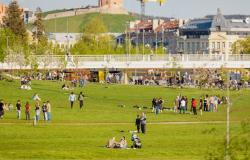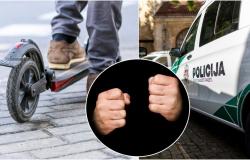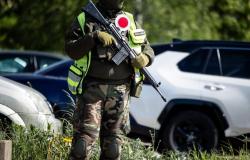Along with trains, the possibilities of traveling by other vehicles are also expanding. This time, traveler Vitoldas Milius checked which way to reach Krakow is faster – by train or by electric car.
The train journey to Poland’s second largest city takes 12 hours, so V. Milius says that this was one of the reasons why he chose an electric car for his race: “It will definitely take less time to cover 800 kilometers in a normal car powered by an internal combustion engine, and if you choose an electric car obviously you will have to stop to charge the battery. It all depends on the model of the electric car, the charging infrastructure and introduces a competitive element. The second purpose of the trip was to check the infrastructure – all Lithuanians traveling to Europe have to pass the same Polish roads, so it was interesting to see what possibilities there are when traveling by electric car.”
Chose a powerful, but not the most economical model
When talking about the trip, V. Milius admits that the car he chose was not the most suitable for long trips – the KIA EV6 GT. It’s an all-wheel drive, 585 hp, 100 km/h crossover. which can reach speed in just 3.5 seconds.
“Probably the most fun with it would be driving in the city”, said the journalist and mentioned that despite the sportiness of this car model, it was driven on highways according to the current road traffic rules.
Some Polish highways have a speed limit of up to 140 km/h, and traffic at 160 km/h. or even faster. However, when driving an electric car and wanting to drive it far, it becomes irrational. The optimal speed, says the traveler, is 120-130 km/h.
As for the first question posed for the trip – which is faster – the answer is very clear: the crew of the powerful electric car eventually managed to reach Krakow forty minutes faster than the train. However, the second question about EV charging infrastructure deserves more comment.
Traveling by electric car has both pros and cons
“For those people who are willing to travel by electric car through Poland, there is no longer such a challenge as there was one year ago. The network of fast charging stations, which is especially important for driving rhythm on long journeys, is already quite wide,” V. Milius teaches.
True, the traveler also notes that it is important what kind of car you are traveling in. The KIA EV6 chosen for this challenge, with its 800-volt system, can charge at a rate of more than 200 kW. This means that it is possible to use basically all the power provided by the fast charging stations, and it will take just a few minutes to recharge the battery from 20 to 80 percent.
Vitoldas Milius, who has already covered many long journeys in an electric car, advises to always keep at least 20 percent energy reserve in the battery: “On this trip, all the stops where we stopped worked, but you never know – if there is a malfunction and the battery has the last drops of energy, you may have a problem. It is also not worth charging above 80 percent, unless you have stopped for a longer time, for example, to have lunch. The charging speed slows down significantly above this limit, so it is usually irrational to wait just for the battery to reach one hundred percent again. Especially if the country has a good network of stops.”
Talking about the still common myth that in order to go abroad with an electric car you have to download a lot of new apps on your phone, the car enthusiast reveals that this time he drove more than one and a half thousand kilometers back and forth using just one Green Way network.
“The Polish crossing route can be constructed using the Green Way network alone. It is probably the most convenient – it has one app, the stops are fast, charging while driving a KIA is cheaper there. True, there is no problem even if you have to download apps from another provider. Compared to what was available a few years ago, all of them are intuitive, easily configurable and easy to use,” said V. Milius.
The journalist did not hide the fact that there are still infrastructural deficiencies. Unlike, for example, Scandinavian countries, where charging stations can charge up to ten electric cars at the same time, charging stations in Poland usually have only a few charging points. Although the crew did not have to wait in line at the power line on this trip, the possibility that they will have to spend more time there than planned remains real.
“After all, there is no longer any challenge and perhaps even no adventure in driving an electric car. You sit and drive like a normal car. Of course, you need to look at the route beforehand and may need to adjust it compared to what you would drive in an internal combustion engine car. Also, more and more hotels offer the possibility of charging in their yard and this is very convenient – you get up, have breakfast and leave with a full battery”, V. Milius summarizes the trip.






